Financial Accounting Report: Balance Sheet and Accounting Concepts
VerifiedAdded on 2019/12/18
|9
|1731
|179
Report
AI Summary
This report delves into the core elements of financial accounting, focusing on the preparation, analysis, and recording of business transactions. It begins by assessing the components of a balance sheet, including assets and liabilities, and illustrates their significance through examples like the income statement and the statement of financial position. The report then explores key accounting concepts such as materiality, duality aspect, going concern, money measurement, and business entity, explaining their roles in financial statement preparation and their implications for decision-making. Each concept is clearly defined and exemplified to enhance understanding. The conclusion emphasizes the importance of these concepts in accurately reflecting a company's financial performance. The report references various books and journals to support its analysis, providing a comprehensive overview of financial accounting principles and their practical application.

Introduction to Financial Accounting
Paraphrase This Document
Need a fresh take? Get an instant paraphrase of this document with our AI Paraphraser
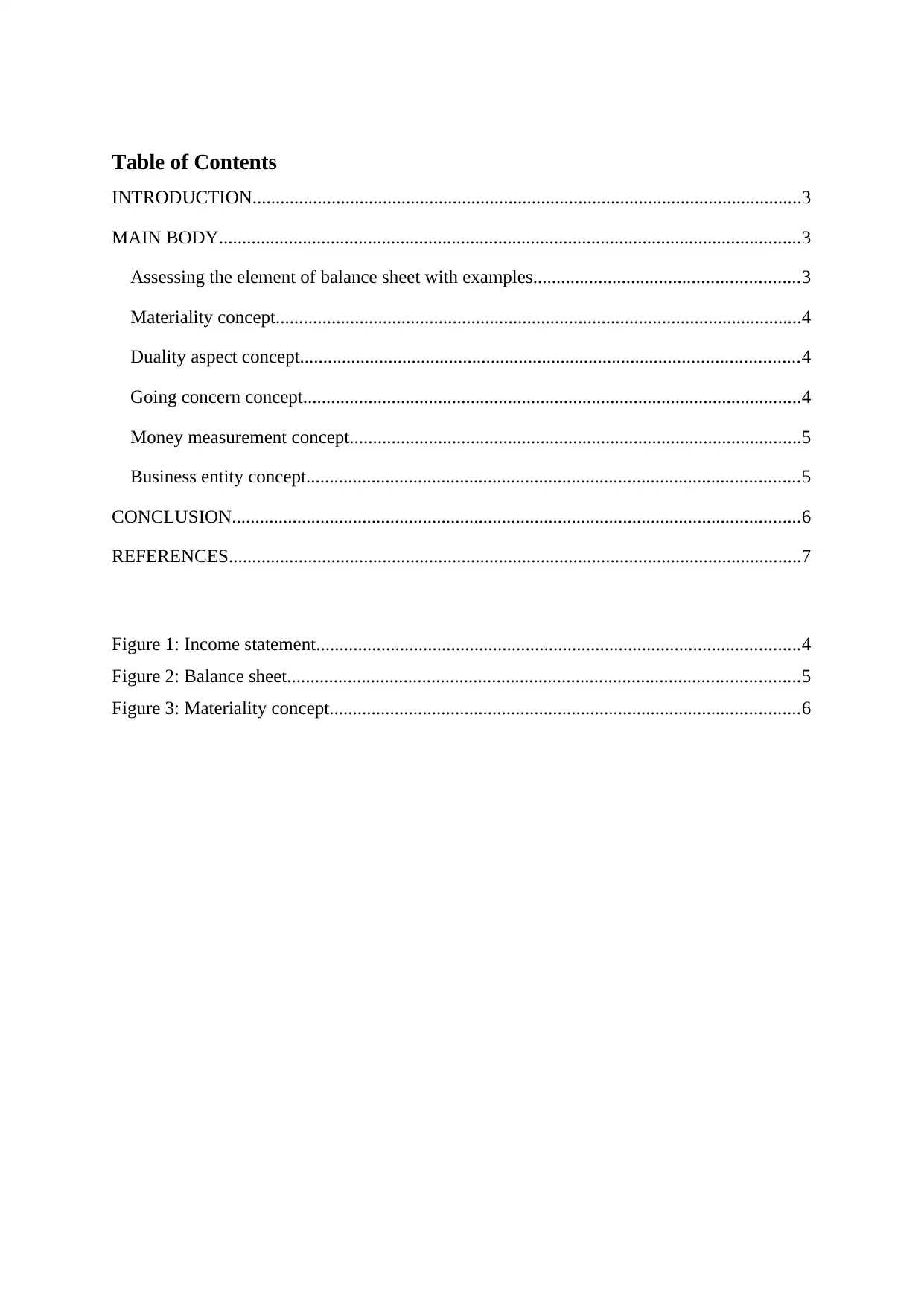
Table of Contents
INTRODUCTION......................................................................................................................3
MAIN BODY.............................................................................................................................3
Assessing the element of balance sheet with examples.........................................................3
Materiality concept.................................................................................................................4
Duality aspect concept...........................................................................................................4
Going concern concept...........................................................................................................4
Money measurement concept.................................................................................................5
Business entity concept..........................................................................................................5
CONCLUSION..........................................................................................................................6
REFERENCES...........................................................................................................................7
Figure 1: Income statement........................................................................................................4
Figure 2: Balance sheet..............................................................................................................5
Figure 3: Materiality concept.....................................................................................................6
INTRODUCTION......................................................................................................................3
MAIN BODY.............................................................................................................................3
Assessing the element of balance sheet with examples.........................................................3
Materiality concept.................................................................................................................4
Duality aspect concept...........................................................................................................4
Going concern concept...........................................................................................................4
Money measurement concept.................................................................................................5
Business entity concept..........................................................................................................5
CONCLUSION..........................................................................................................................6
REFERENCES...........................................................................................................................7
Figure 1: Income statement........................................................................................................4
Figure 2: Balance sheet..............................................................................................................5
Figure 3: Materiality concept.....................................................................................................6
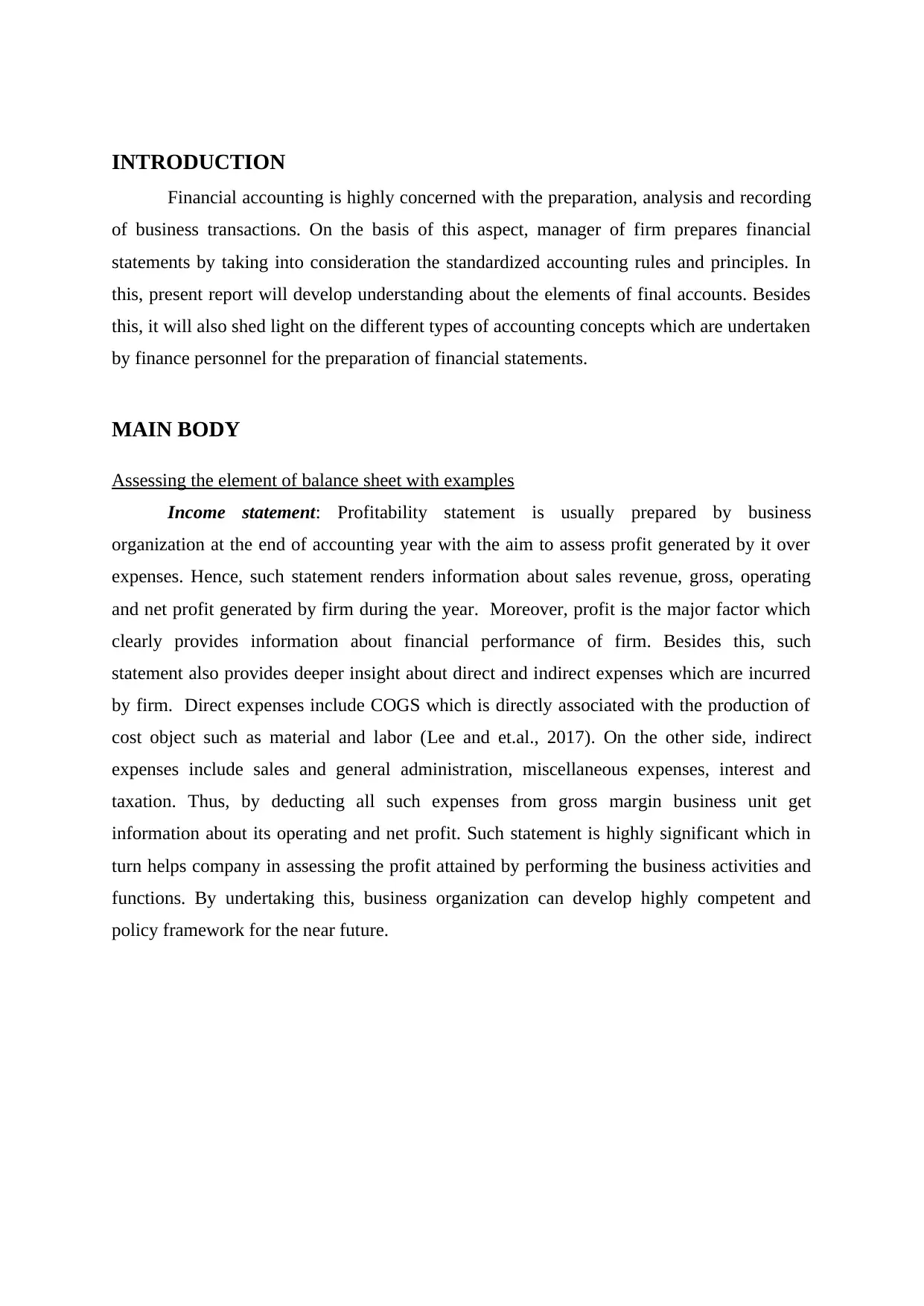
INTRODUCTION
Financial accounting is highly concerned with the preparation, analysis and recording
of business transactions. On the basis of this aspect, manager of firm prepares financial
statements by taking into consideration the standardized accounting rules and principles. In
this, present report will develop understanding about the elements of final accounts. Besides
this, it will also shed light on the different types of accounting concepts which are undertaken
by finance personnel for the preparation of financial statements.
MAIN BODY
Assessing the element of balance sheet with examples
Income statement: Profitability statement is usually prepared by business
organization at the end of accounting year with the aim to assess profit generated by it over
expenses. Hence, such statement renders information about sales revenue, gross, operating
and net profit generated by firm during the year. Moreover, profit is the major factor which
clearly provides information about financial performance of firm. Besides this, such
statement also provides deeper insight about direct and indirect expenses which are incurred
by firm. Direct expenses include COGS which is directly associated with the production of
cost object such as material and labor (Lee and et.al., 2017). On the other side, indirect
expenses include sales and general administration, miscellaneous expenses, interest and
taxation. Thus, by deducting all such expenses from gross margin business unit get
information about its operating and net profit. Such statement is highly significant which in
turn helps company in assessing the profit attained by performing the business activities and
functions. By undertaking this, business organization can develop highly competent and
policy framework for the near future.
Financial accounting is highly concerned with the preparation, analysis and recording
of business transactions. On the basis of this aspect, manager of firm prepares financial
statements by taking into consideration the standardized accounting rules and principles. In
this, present report will develop understanding about the elements of final accounts. Besides
this, it will also shed light on the different types of accounting concepts which are undertaken
by finance personnel for the preparation of financial statements.
MAIN BODY
Assessing the element of balance sheet with examples
Income statement: Profitability statement is usually prepared by business
organization at the end of accounting year with the aim to assess profit generated by it over
expenses. Hence, such statement renders information about sales revenue, gross, operating
and net profit generated by firm during the year. Moreover, profit is the major factor which
clearly provides information about financial performance of firm. Besides this, such
statement also provides deeper insight about direct and indirect expenses which are incurred
by firm. Direct expenses include COGS which is directly associated with the production of
cost object such as material and labor (Lee and et.al., 2017). On the other side, indirect
expenses include sales and general administration, miscellaneous expenses, interest and
taxation. Thus, by deducting all such expenses from gross margin business unit get
information about its operating and net profit. Such statement is highly significant which in
turn helps company in assessing the profit attained by performing the business activities and
functions. By undertaking this, business organization can develop highly competent and
policy framework for the near future.
⊘ This is a preview!⊘
Do you want full access?
Subscribe today to unlock all pages.

Trusted by 1+ million students worldwide
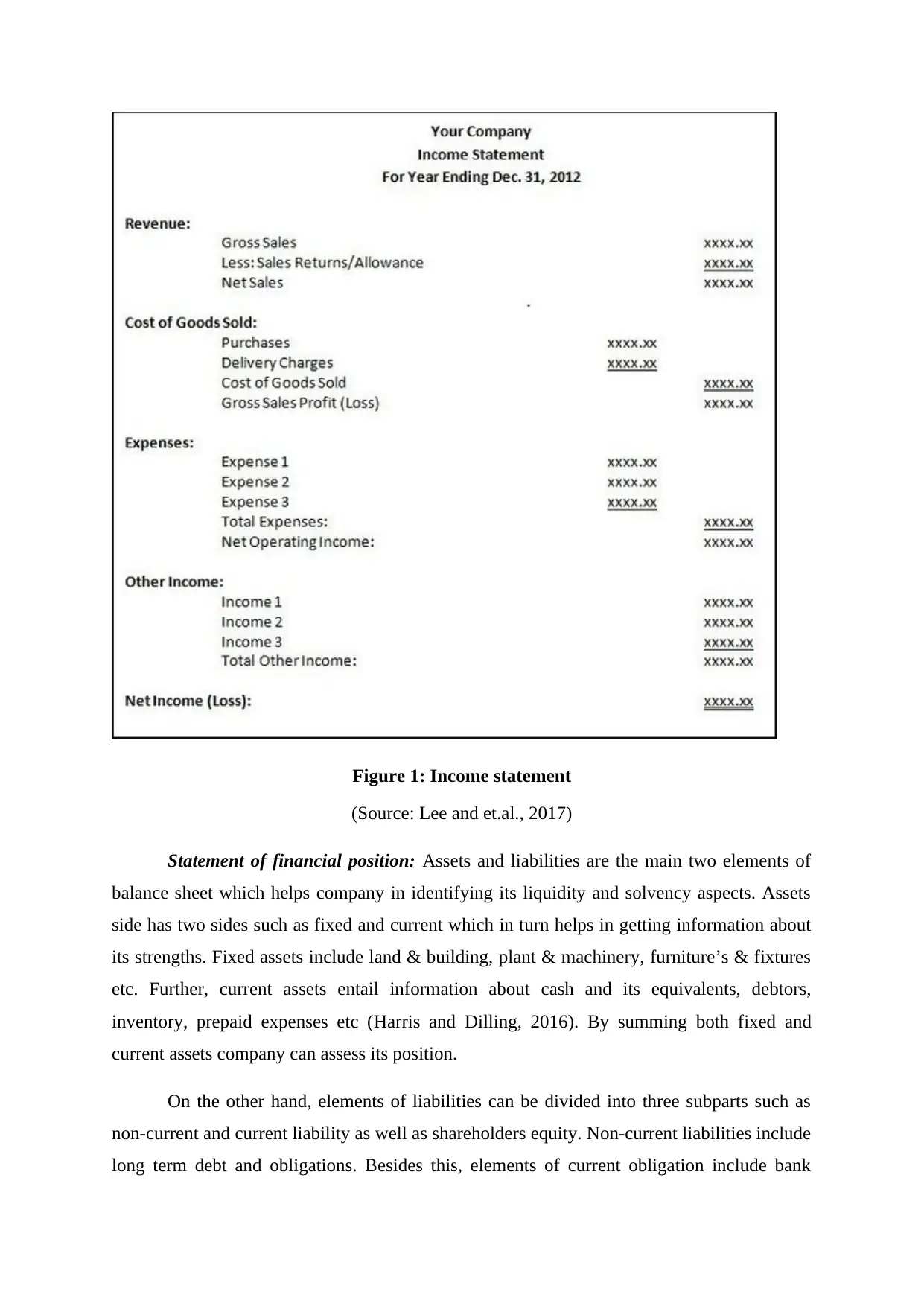
Figure 1: Income statement
(Source: Lee and et.al., 2017)
Statement of financial position: Assets and liabilities are the main two elements of
balance sheet which helps company in identifying its liquidity and solvency aspects. Assets
side has two sides such as fixed and current which in turn helps in getting information about
its strengths. Fixed assets include land & building, plant & machinery, furniture’s & fixtures
etc. Further, current assets entail information about cash and its equivalents, debtors,
inventory, prepaid expenses etc (Harris and Dilling, 2016). By summing both fixed and
current assets company can assess its position.
On the other hand, elements of liabilities can be divided into three subparts such as
non-current and current liability as well as shareholders equity. Non-current liabilities include
long term debt and obligations. Besides this, elements of current obligation include bank
(Source: Lee and et.al., 2017)
Statement of financial position: Assets and liabilities are the main two elements of
balance sheet which helps company in identifying its liquidity and solvency aspects. Assets
side has two sides such as fixed and current which in turn helps in getting information about
its strengths. Fixed assets include land & building, plant & machinery, furniture’s & fixtures
etc. Further, current assets entail information about cash and its equivalents, debtors,
inventory, prepaid expenses etc (Harris and Dilling, 2016). By summing both fixed and
current assets company can assess its position.
On the other hand, elements of liabilities can be divided into three subparts such as
non-current and current liability as well as shareholders equity. Non-current liabilities include
long term debt and obligations. Besides this, elements of current obligation include bank
Paraphrase This Document
Need a fresh take? Get an instant paraphrase of this document with our AI Paraphraser
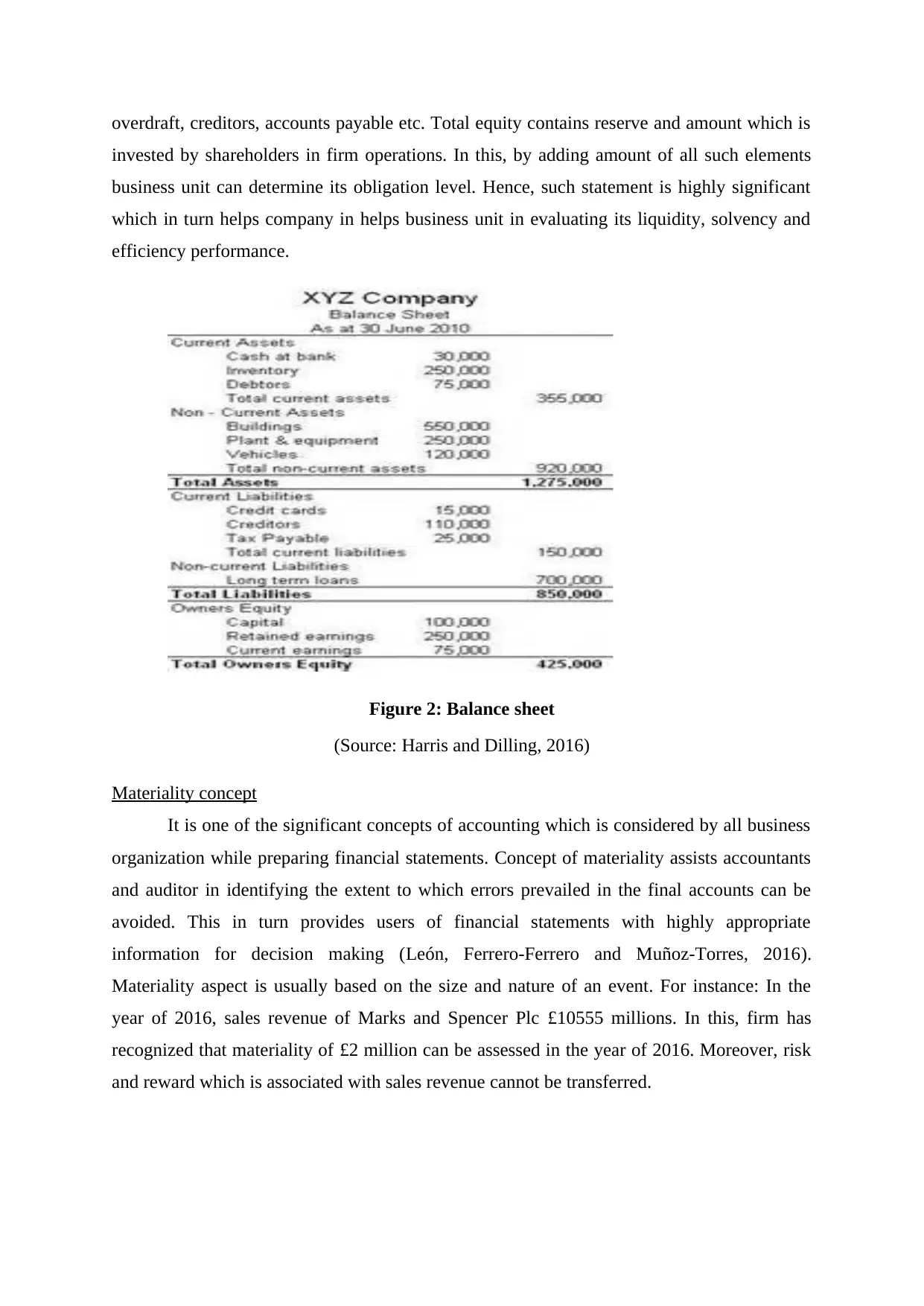
overdraft, creditors, accounts payable etc. Total equity contains reserve and amount which is
invested by shareholders in firm operations. In this, by adding amount of all such elements
business unit can determine its obligation level. Hence, such statement is highly significant
which in turn helps company in helps business unit in evaluating its liquidity, solvency and
efficiency performance.
Figure 2: Balance sheet
(Source: Harris and Dilling, 2016)
Materiality concept
It is one of the significant concepts of accounting which is considered by all business
organization while preparing financial statements. Concept of materiality assists accountants
and auditor in identifying the extent to which errors prevailed in the final accounts can be
avoided. This in turn provides users of financial statements with highly appropriate
information for decision making (León, Ferrero-Ferrero and Muñoz-Torres, 2016).
Materiality aspect is usually based on the size and nature of an event. For instance: In the
year of 2016, sales revenue of Marks and Spencer Plc £10555 millions. In this, firm has
recognized that materiality of £2 million can be assessed in the year of 2016. Moreover, risk
and reward which is associated with sales revenue cannot be transferred.
invested by shareholders in firm operations. In this, by adding amount of all such elements
business unit can determine its obligation level. Hence, such statement is highly significant
which in turn helps company in helps business unit in evaluating its liquidity, solvency and
efficiency performance.
Figure 2: Balance sheet
(Source: Harris and Dilling, 2016)
Materiality concept
It is one of the significant concepts of accounting which is considered by all business
organization while preparing financial statements. Concept of materiality assists accountants
and auditor in identifying the extent to which errors prevailed in the final accounts can be
avoided. This in turn provides users of financial statements with highly appropriate
information for decision making (León, Ferrero-Ferrero and Muñoz-Torres, 2016).
Materiality aspect is usually based on the size and nature of an event. For instance: In the
year of 2016, sales revenue of Marks and Spencer Plc £10555 millions. In this, firm has
recognized that materiality of £2 million can be assessed in the year of 2016. Moreover, risk
and reward which is associated with sales revenue cannot be transferred.
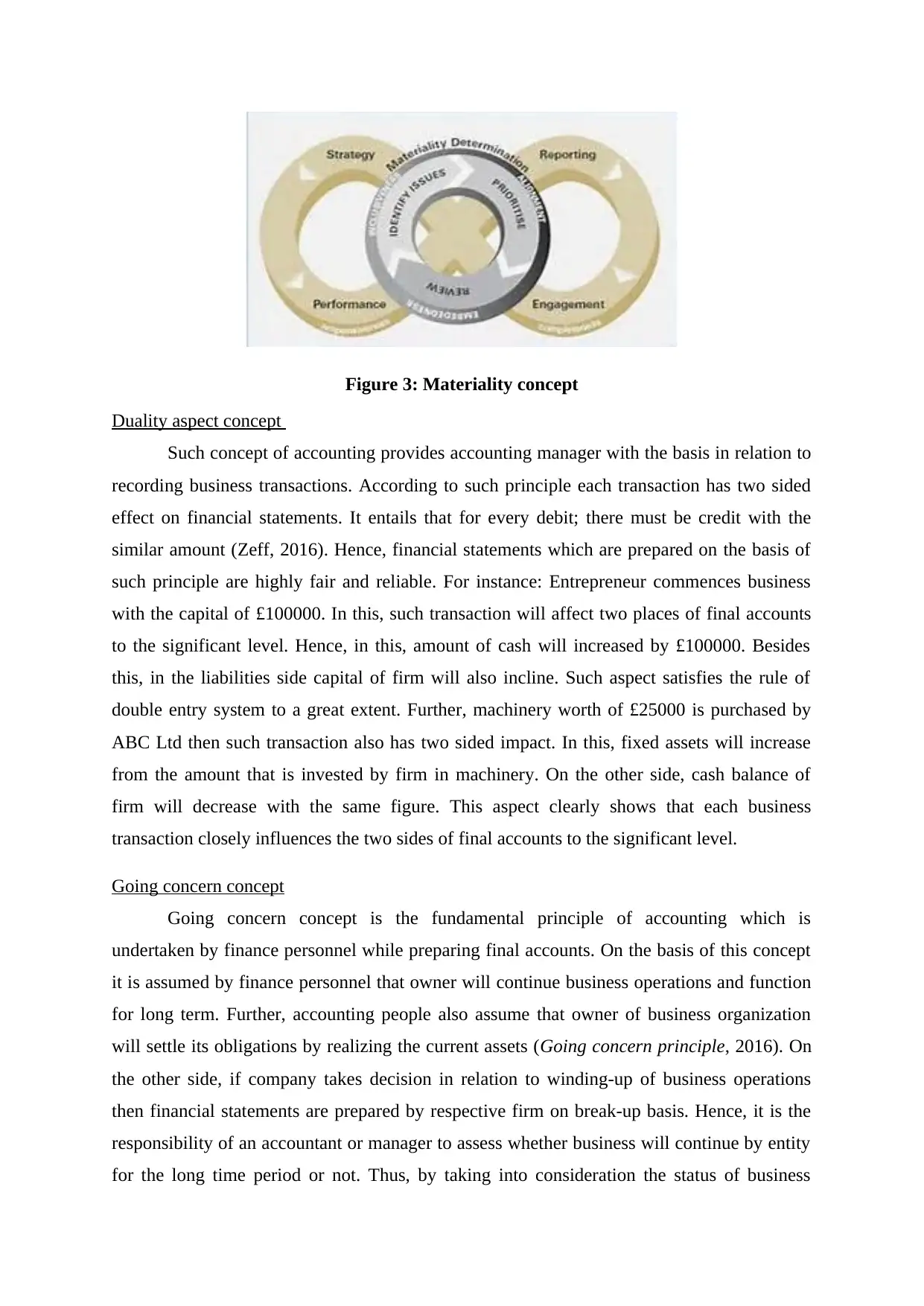
Figure 3: Materiality concept
Duality aspect concept
Such concept of accounting provides accounting manager with the basis in relation to
recording business transactions. According to such principle each transaction has two sided
effect on financial statements. It entails that for every debit; there must be credit with the
similar amount (Zeff, 2016). Hence, financial statements which are prepared on the basis of
such principle are highly fair and reliable. For instance: Entrepreneur commences business
with the capital of £100000. In this, such transaction will affect two places of final accounts
to the significant level. Hence, in this, amount of cash will increased by £100000. Besides
this, in the liabilities side capital of firm will also incline. Such aspect satisfies the rule of
double entry system to a great extent. Further, machinery worth of £25000 is purchased by
ABC Ltd then such transaction also has two sided impact. In this, fixed assets will increase
from the amount that is invested by firm in machinery. On the other side, cash balance of
firm will decrease with the same figure. This aspect clearly shows that each business
transaction closely influences the two sides of final accounts to the significant level.
Going concern concept
Going concern concept is the fundamental principle of accounting which is
undertaken by finance personnel while preparing final accounts. On the basis of this concept
it is assumed by finance personnel that owner will continue business operations and function
for long term. Further, accounting people also assume that owner of business organization
will settle its obligations by realizing the current assets (Going concern principle, 2016). On
the other side, if company takes decision in relation to winding-up of business operations
then financial statements are prepared by respective firm on break-up basis. Hence, it is the
responsibility of an accountant or manager to assess whether business will continue by entity
for the long time period or not. Thus, by taking into consideration the status of business
Duality aspect concept
Such concept of accounting provides accounting manager with the basis in relation to
recording business transactions. According to such principle each transaction has two sided
effect on financial statements. It entails that for every debit; there must be credit with the
similar amount (Zeff, 2016). Hence, financial statements which are prepared on the basis of
such principle are highly fair and reliable. For instance: Entrepreneur commences business
with the capital of £100000. In this, such transaction will affect two places of final accounts
to the significant level. Hence, in this, amount of cash will increased by £100000. Besides
this, in the liabilities side capital of firm will also incline. Such aspect satisfies the rule of
double entry system to a great extent. Further, machinery worth of £25000 is purchased by
ABC Ltd then such transaction also has two sided impact. In this, fixed assets will increase
from the amount that is invested by firm in machinery. On the other side, cash balance of
firm will decrease with the same figure. This aspect clearly shows that each business
transaction closely influences the two sides of final accounts to the significant level.
Going concern concept
Going concern concept is the fundamental principle of accounting which is
undertaken by finance personnel while preparing final accounts. On the basis of this concept
it is assumed by finance personnel that owner will continue business operations and function
for long term. Further, accounting people also assume that owner of business organization
will settle its obligations by realizing the current assets (Going concern principle, 2016). On
the other side, if company takes decision in relation to winding-up of business operations
then financial statements are prepared by respective firm on break-up basis. Hence, it is the
responsibility of an accountant or manager to assess whether business will continue by entity
for the long time period or not. Thus, by taking into consideration the status of business
⊘ This is a preview!⊘
Do you want full access?
Subscribe today to unlock all pages.

Trusted by 1+ million students worldwide
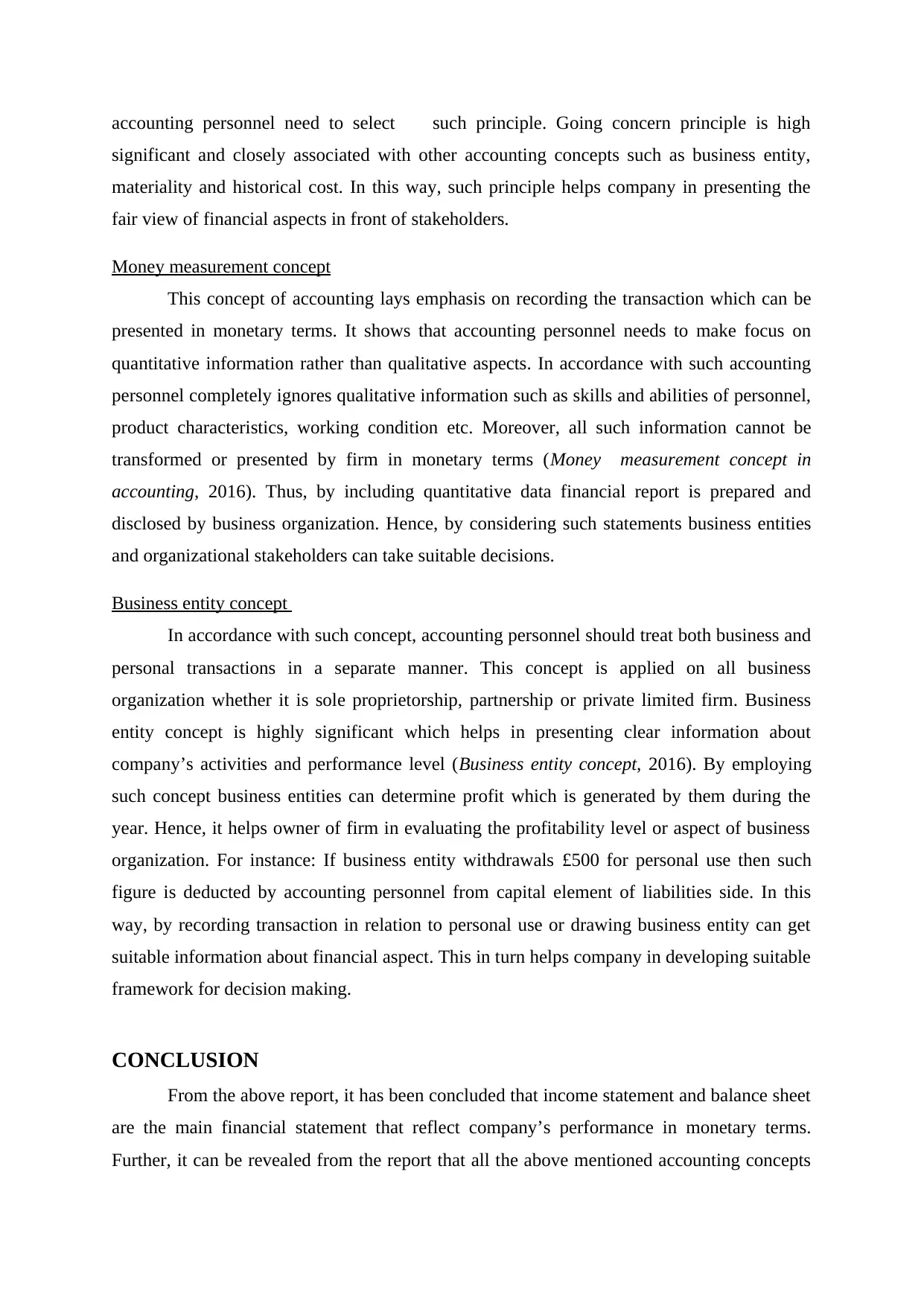
accounting personnel need to select such principle. Going concern principle is high
significant and closely associated with other accounting concepts such as business entity,
materiality and historical cost. In this way, such principle helps company in presenting the
fair view of financial aspects in front of stakeholders.
Money measurement concept
This concept of accounting lays emphasis on recording the transaction which can be
presented in monetary terms. It shows that accounting personnel needs to make focus on
quantitative information rather than qualitative aspects. In accordance with such accounting
personnel completely ignores qualitative information such as skills and abilities of personnel,
product characteristics, working condition etc. Moreover, all such information cannot be
transformed or presented by firm in monetary terms (Money measurement concept in
accounting, 2016). Thus, by including quantitative data financial report is prepared and
disclosed by business organization. Hence, by considering such statements business entities
and organizational stakeholders can take suitable decisions.
Business entity concept
In accordance with such concept, accounting personnel should treat both business and
personal transactions in a separate manner. This concept is applied on all business
organization whether it is sole proprietorship, partnership or private limited firm. Business
entity concept is highly significant which helps in presenting clear information about
company’s activities and performance level (Business entity concept, 2016). By employing
such concept business entities can determine profit which is generated by them during the
year. Hence, it helps owner of firm in evaluating the profitability level or aspect of business
organization. For instance: If business entity withdrawals £500 for personal use then such
figure is deducted by accounting personnel from capital element of liabilities side. In this
way, by recording transaction in relation to personal use or drawing business entity can get
suitable information about financial aspect. This in turn helps company in developing suitable
framework for decision making.
CONCLUSION
From the above report, it has been concluded that income statement and balance sheet
are the main financial statement that reflect company’s performance in monetary terms.
Further, it can be revealed from the report that all the above mentioned accounting concepts
significant and closely associated with other accounting concepts such as business entity,
materiality and historical cost. In this way, such principle helps company in presenting the
fair view of financial aspects in front of stakeholders.
Money measurement concept
This concept of accounting lays emphasis on recording the transaction which can be
presented in monetary terms. It shows that accounting personnel needs to make focus on
quantitative information rather than qualitative aspects. In accordance with such accounting
personnel completely ignores qualitative information such as skills and abilities of personnel,
product characteristics, working condition etc. Moreover, all such information cannot be
transformed or presented by firm in monetary terms (Money measurement concept in
accounting, 2016). Thus, by including quantitative data financial report is prepared and
disclosed by business organization. Hence, by considering such statements business entities
and organizational stakeholders can take suitable decisions.
Business entity concept
In accordance with such concept, accounting personnel should treat both business and
personal transactions in a separate manner. This concept is applied on all business
organization whether it is sole proprietorship, partnership or private limited firm. Business
entity concept is highly significant which helps in presenting clear information about
company’s activities and performance level (Business entity concept, 2016). By employing
such concept business entities can determine profit which is generated by them during the
year. Hence, it helps owner of firm in evaluating the profitability level or aspect of business
organization. For instance: If business entity withdrawals £500 for personal use then such
figure is deducted by accounting personnel from capital element of liabilities side. In this
way, by recording transaction in relation to personal use or drawing business entity can get
suitable information about financial aspect. This in turn helps company in developing suitable
framework for decision making.
CONCLUSION
From the above report, it has been concluded that income statement and balance sheet
are the main financial statement that reflect company’s performance in monetary terms.
Further, it can be revealed from the report that all the above mentioned accounting concepts
Paraphrase This Document
Need a fresh take? Get an instant paraphrase of this document with our AI Paraphraser

are highly significant which in turn helps in framing financial statements in an appropriate
way.
way.
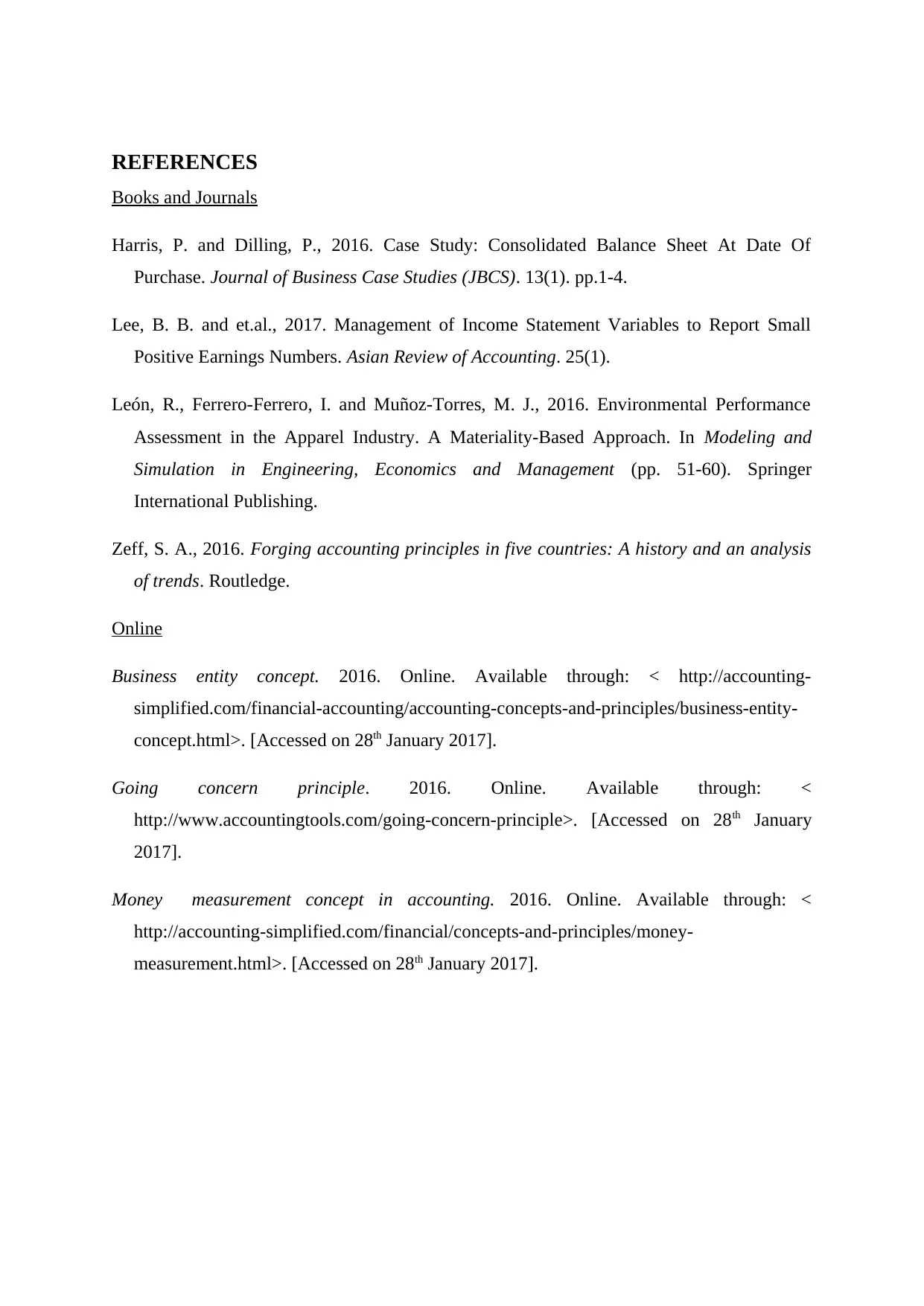
REFERENCES
Books and Journals
Harris, P. and Dilling, P., 2016. Case Study: Consolidated Balance Sheet At Date Of
Purchase. Journal of Business Case Studies (JBCS). 13(1). pp.1-4.
Lee, B. B. and et.al., 2017. Management of Income Statement Variables to Report Small
Positive Earnings Numbers. Asian Review of Accounting. 25(1).
León, R., Ferrero-Ferrero, I. and Muñoz-Torres, M. J., 2016. Environmental Performance
Assessment in the Apparel Industry. A Materiality-Based Approach. In Modeling and
Simulation in Engineering, Economics and Management (pp. 51-60). Springer
International Publishing.
Zeff, S. A., 2016. Forging accounting principles in five countries: A history and an analysis
of trends. Routledge.
Online
Business entity concept. 2016. Online. Available through: < http://accounting-
simplified.com/financial-accounting/accounting-concepts-and-principles/business-entity-
concept.html>. [Accessed on 28th January 2017].
Going concern principle. 2016. Online. Available through: <
http://www.accountingtools.com/going-concern-principle>. [Accessed on 28th January
2017].
Money measurement concept in accounting. 2016. Online. Available through: <
http://accounting-simplified.com/financial/concepts-and-principles/money-
measurement.html>. [Accessed on 28th January 2017].
Books and Journals
Harris, P. and Dilling, P., 2016. Case Study: Consolidated Balance Sheet At Date Of
Purchase. Journal of Business Case Studies (JBCS). 13(1). pp.1-4.
Lee, B. B. and et.al., 2017. Management of Income Statement Variables to Report Small
Positive Earnings Numbers. Asian Review of Accounting. 25(1).
León, R., Ferrero-Ferrero, I. and Muñoz-Torres, M. J., 2016. Environmental Performance
Assessment in the Apparel Industry. A Materiality-Based Approach. In Modeling and
Simulation in Engineering, Economics and Management (pp. 51-60). Springer
International Publishing.
Zeff, S. A., 2016. Forging accounting principles in five countries: A history and an analysis
of trends. Routledge.
Online
Business entity concept. 2016. Online. Available through: < http://accounting-
simplified.com/financial-accounting/accounting-concepts-and-principles/business-entity-
concept.html>. [Accessed on 28th January 2017].
Going concern principle. 2016. Online. Available through: <
http://www.accountingtools.com/going-concern-principle>. [Accessed on 28th January
2017].
Money measurement concept in accounting. 2016. Online. Available through: <
http://accounting-simplified.com/financial/concepts-and-principles/money-
measurement.html>. [Accessed on 28th January 2017].
⊘ This is a preview!⊘
Do you want full access?
Subscribe today to unlock all pages.

Trusted by 1+ million students worldwide
1 out of 9
Related Documents
Your All-in-One AI-Powered Toolkit for Academic Success.
+13062052269
info@desklib.com
Available 24*7 on WhatsApp / Email
![[object Object]](/_next/static/media/star-bottom.7253800d.svg)
Unlock your academic potential
© 2024 | Zucol Services PVT LTD | All rights reserved.




